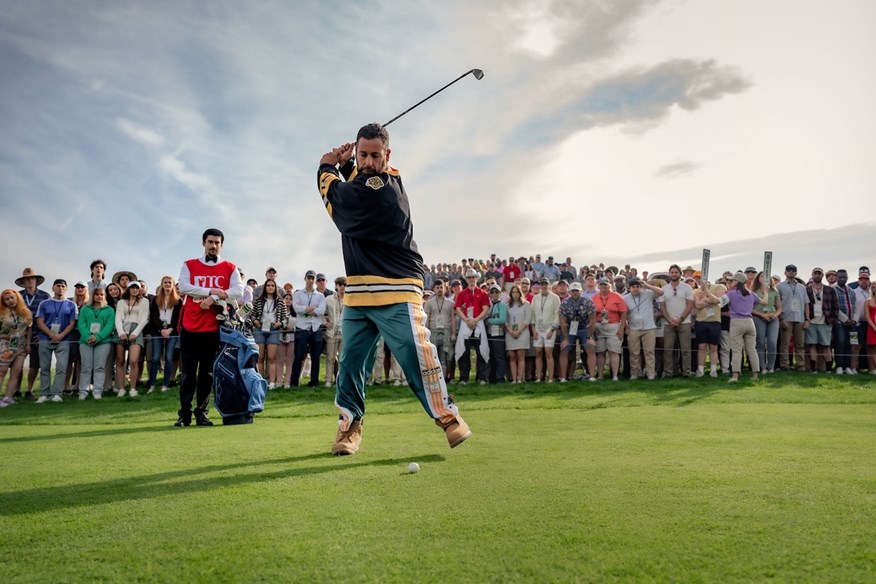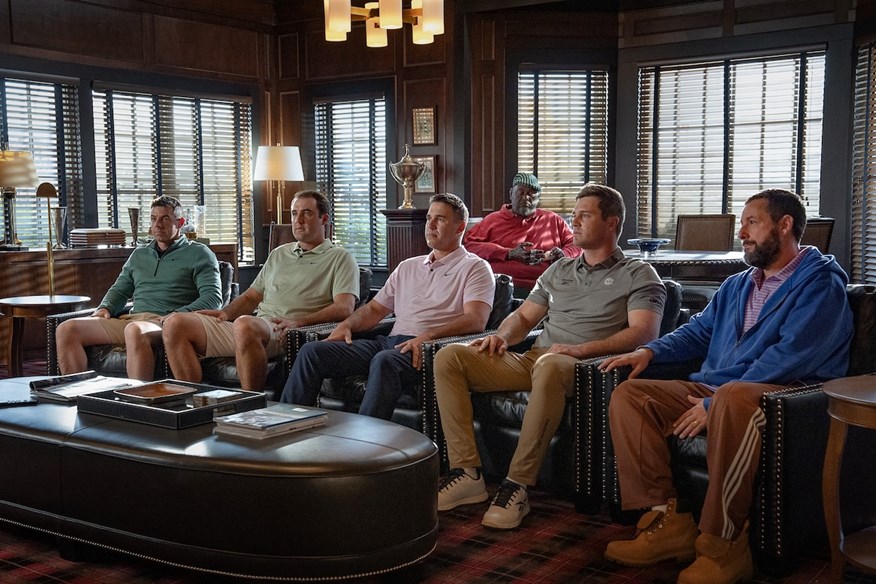10 things we liked – and didn’t like – about Happy Gilmore 2 (with no spoilers)
Last updated:

Our resident Adam Sandler Fan Club member has watched it through twice. So here’s his Happy Gilmore 2 review – with a few things he thought worked, and some that should have been left on the cutting room floor. And don’t worry – this is a spoiler-free zone…
Hi, I’m Alex and I’m a Sandlerholic.
I’ve always considered my sense of humor to be more on the right side of the sophistication-slapstick divide. I grew up watching The Simpsons (strictly seasons 1-10, of course), Cheers, Seinfeld, then The Office, Peep Show, the various incarnations of Alan Partridge, and so on.
But there was something about Adam Sandler that always had me stumbling over that line. The way he managed to find the perfect blend of farce, heart, and genuinely good jokes has – in the 30 years since I first saw Billy Madison – had me always coming back for more. Throw in some of the best vibes of the ‘80s and a hopelessly romantic Wedding Singer, and you’ve got the makeup for one of the best comedy films ever made.
But it was a little flick called in between those two that rocketed Sandler to superstardom and changed not only world of sports comedies but the game of golf forever.
Suddenly, everyone was doing the “Happy Gilmore swing” down at the range. (Some were doing it on the course too, but I told the greenkeeper it wasn’t me and I’m sticking to my story.)
Somewhat perversely, the eponymous antihero was born of Sandler’s aversion toward the game. It shows plenty in the film – “Golf requires goofy pants and a fat ass!” – but his dad was an avid player. Sandler Sr, frustrated at his son’s lack of interest, would ask him to bring a friend along to the driving range. That friend was Kyle McDonough, a promising hockey player who would later turn pro.
The story, which Sandler has told many times, goes that McDonough could hit the ball so much further than anyone else at the club. So when he started writing films, he and fellow comedian Tim Herlihy were spitballing an idea about a golfer with a hockey player mentality, and the rest, as they say, is history.
There was one problem. Golfers didn’t like it. And neither did the critics. The New York Times called it “boorish”. The Chicago Sun-Times described it as “the story of a violent sociopath”. More observational than critical, if you ask me. As golf films went, they claimed, it couldn’t hold a candle to the far more sophisticated Caddyshack and it’s jokes about a greenkeeper waging war on a fake gopher. (Don’t @ me, I love it.)
It didn’t matter. Happy Gilmore became both a commercial and cult success. Which is precisely why, for almost 30 years, fans pleaded for a sequel.
Then, when Netflix bought the rights to Happy Madison Productions’ back catalogue, they inadvertently made the company’s CEO the biggest film star on the planet. In a world dominated by the likes of Channing Tatum, Jennifer Lawrence and Chris Pratt, it was an almost 50-year-old Sandler who became the highest-paid actor in Hollywood.
With all that money, though, came a contract to make lots of films. And while he smashed it out of the park with the likes of Hustle and Uncut Gems, as well as a rousing return to his stand-up roots with specials 100% Fresh and Love You, there was one thing anyone who had ever tried the “hop, skip and hit” method yearned.
Even when Sandler and Herlihy announced Happy Gilmore 2, there was more of a sense of trepidation in the air than excitement.
Comedy sequels are, as a rule, generally only made as cash grabs and are very rarely better than the original. Take a few moments and see if you can think of one. We’ve got time. As for sports comedy sequels – forget about it. Don’t believe me? Caddyshack rates a solid 73 percent on Rotten Tomatoes. Caddyshack II? Four percent.
But after months of build-up and talk of countless cameos, Happy Gilmore 2 has finally dropped on the streaming service.
So this is me, taking my ASFC hat off for a few minutes to jot down a few notes which I will definitely rewrite at least 50 times over the coming weeks…
Happy Gilmore 2 review
Right, let’s get get into it. I’ve written 10 in the headline but who’s counting?
Before we do, though, there are no spoilers here. (Unless you’ve been living under a rock and somehow missed that John Daly and co all have starring roles.)
What I liked
Let’s start with the good stuff. First of all, Happy 2.0 is exactly how you want him to be. Not many can make you root for a deadbeat jackass the way Sandler can.
Christopher McDonald as Gilmore’s nemesis Shooter McGavin has a whole new dynamic and energy which is so much better than I could ever have imagined.
There are also plenty of genuinely heartfelt nods to stars of the original who are sadly no longer with us, but it also means that the opening 15 minutes, used to poignantly set up the remainder of the film, are almost certainly going to be bits the hardcore fans remember.
I, like so many, was nervous about the sheer number of cameos. But if you’re going to make it work in any kind of film, why not make it a golf film, right? The sport is riddled with celebrity appearances anyway and, after all, it didn’t exactly hurt the original.
We all knew a host of big-name golfers such as Rory McIlroy and Scottie Scheffler were going to be in it, but there were certainly a couple of surprise walk-on parts for you to look out for – a couple of which are genuinely laugh-out-loud.

Among them is Daly, whose supporting role is damn near perfect, Bad Bunny is excellent as Gilmore’s busboy-turned-bagman, Oscar, while Sandler really leans into the ongoing social media gag that his young caddie in the original film looks exactly like PGA Tour star Will Zalatoris – even if the math ain’t mathing. Zalatoris, by the way, can fall seamlessly into an acting career if his back problems get the better of him. If the guy could putt as well as he can deliver a punchline, he’d be a multiple major winner by now.
Speaking of surprisingly good acting, Scheffler shines with a couple of brilliant lines, including a topical gag with a fabulous payoff. Jack Nicklaus has a joke that, even though you can see the punchline a mile off, made me laugh out loud. But in the same scene, a back-and-forth between Rickie Fowler and Xander Schauffele, while delivered well by the multiple PGA Tour champions, doesn’t quite hit the spot on a comedic level.
Also producing a snort laugh from this reviewer was a particularly hilarious and unexpected one-liner from Bryson DeChambeau. You can certainly feel the influence of sitcoms that were huge hits between the two films.
It also satirizes the current situation in golf very well with an ongoing runner throughout about the “clown league”, which is clearly poking fun at LIV Golf and – if you’ve been following it in real life – you’ll enjoy the irony in the roles played by Bryson DeChambeau, Brooks Koepka and Bubba Watson in the second half. And – just for fun – see if you can work out the pun they’re making in the name of the rival league’s creator.
What I didn’t like
OK, the bad stuff.
First of all, Sandler drops a huge bomb on us right at the start of the film. Like, literally three minutes in. And it’s brutal. I genuinely had to pause it for a few moments to compose myself.
The note on my pad simply says: “3:19 – WTF?!” Taking off that particular cap, though, and putting on my newly-acquired film critic one, it does set up the rest of the film very well and allows it to essentially follow the same plotline as the original.
That said, I didn’t particularly enjoy the fact Sandler uses a debilitating disease as a running joke. I’m the last person to get offended by these sorts of things, before you start calling me “woke” or a “snowflake”, but it just feels like it’s in bad taste – especially when they’re using said disease for tactless product placement throughout.
Elsewhere, there are plenty of lovely callbacks to the first film that normally would be really appreciated by fans. The problem is, with the desire to ensure anyone who hadn’t seen the original could appreciate them, they included a number of flashback clips that just felt jarring when they appeared. Some, it should be noted, like how they repurposed the famous “happy place” scene, worked to a tee. (Pun intended.)
There are also a number of questionable casting choices. Benny Safdie plays the villain well, but the Marvelization of the role didn’t work at all – particularly when you contrast it against McGavin in the first film – while the ongoing joke about bad breath just ended up being as irritating as the character himself. And having Haley Joel Osment as his tormentor-in-chief was terribly wide of the mark. Sorry, is that the kid from The Sixth Sense trying to tear down the establishment?
Another returning favorite included Ben Stiller as Hal, but his callous care home character has a new role that turns out to just be unnecessarily mean for the sake of it. It felt like there were plenty of better ways to go with this.
And McIlroy? Well, let’s just say he’s lucky he’s incredibly good at golf.
But Happy Gilmore 2’s main problem is that it simply runs on too long.
As a result, the third act shifts too far from silly to surreal, and when it does inevitably return to reality for those final few emotional scenes that Sandler does so well in his movies, it’s difficult to focus because of the preposterous route we took to get there.
Verdict

When it comes to combining slapstick with sentiment, Sandler never misses. It’s as juvenile as it is touching – but, until that last 20 minutes or so, it rarely leans too far one way or the other.
There are way more big misses than hole-outs than the first one. But I laughed. A lot. And I cried. A bit.
Most importantly, if you loved the original, you will love this too.
Right, Adam, now that’s done, we need to know what Billy Madison is up to these days. And while you’re at it, there’s a certain wedding singer who surely has an updated playlist…
8/10
